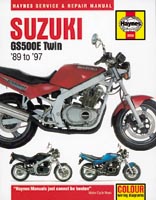The GS500E Twin
The motor may have been around for a good while in one form or another, but Suzuki did an excellent job with the totally new chassis and running gear to produce a motorcycle with looks sharp enough to belie its utilitarian specification. Here was a bike that was aimed at the rider on a budget, the rider who had just passed his or her test, and the big-city despatch riding market, yet it didn't look like like a workhorse. Suzuki had got their planning right, the bike sold well and was well reviewed on both sides of the Atlantic.
There were very few signs of the GS500E being built down to a price, with the possible exception of the front fork. The front fork was very soft and did a good impression of a high-speed lift under even gentle braking. This complaint was addressed on the UK 1992 model, the GS500EN, by fitting higher-rate fork springs and the incorporation of preload adjusters in the fork top bolts.
The only mechanical modification to the GS related to the cylinder head. Like all air-cooled motors, the GS produced a good deal of noise when cold and alot of it came from camshaft endfloat. From engine number 114497 onwards the clearance was opened up to a theoretical 1 mm by taking 0.5 mm off the head casting and the same amount off the end of the camshaft. This clearance was shimmed up with a 1 mm shim to give "almost no clearance when cold"-the theory being that differential rates of expansion between the cylinder head and the camshaft would produce working clearance once the motor was warm. Like the fork modification, it worked well enough to stop the roadtesters mentioning the problem again.
The only other changes to the GS500E have been cosmetic. This is not a model that the factory wants to spend money on altering every year, after all the whole idea was to produce a budget bike. As you'd expect, the factory changed the paint scheme every year - some being more pleasing on the eye than others! The UK importer has, however, seen fit to offer an after-market fairing as an option. This is not a factory product, in fact it is sourced in Spain, but it does fit in with the surprisingly sporty lines of the GS500E. Owners also have the option of a quarter fairing and chin fairing.
The new-generation has carried on the tradition of those original GS-fours in providing reliable, even bullet-proof, riding and while it may be a budget bike it is also a very good bike.
